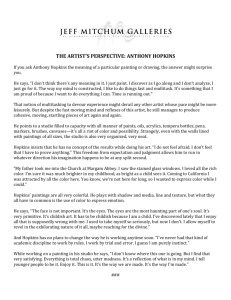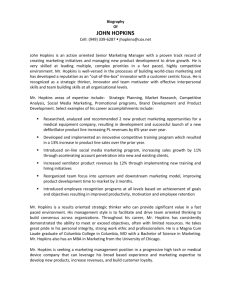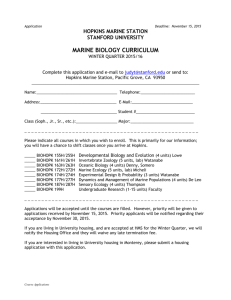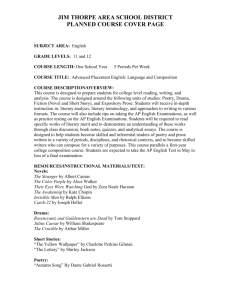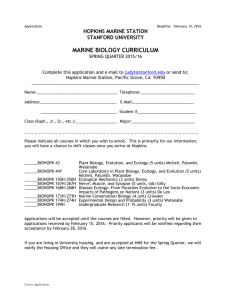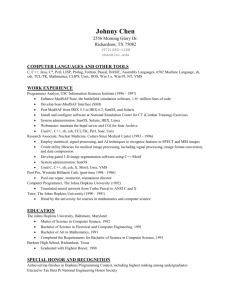Hopkins Creative Use of Heraclitean Materials
advertisement
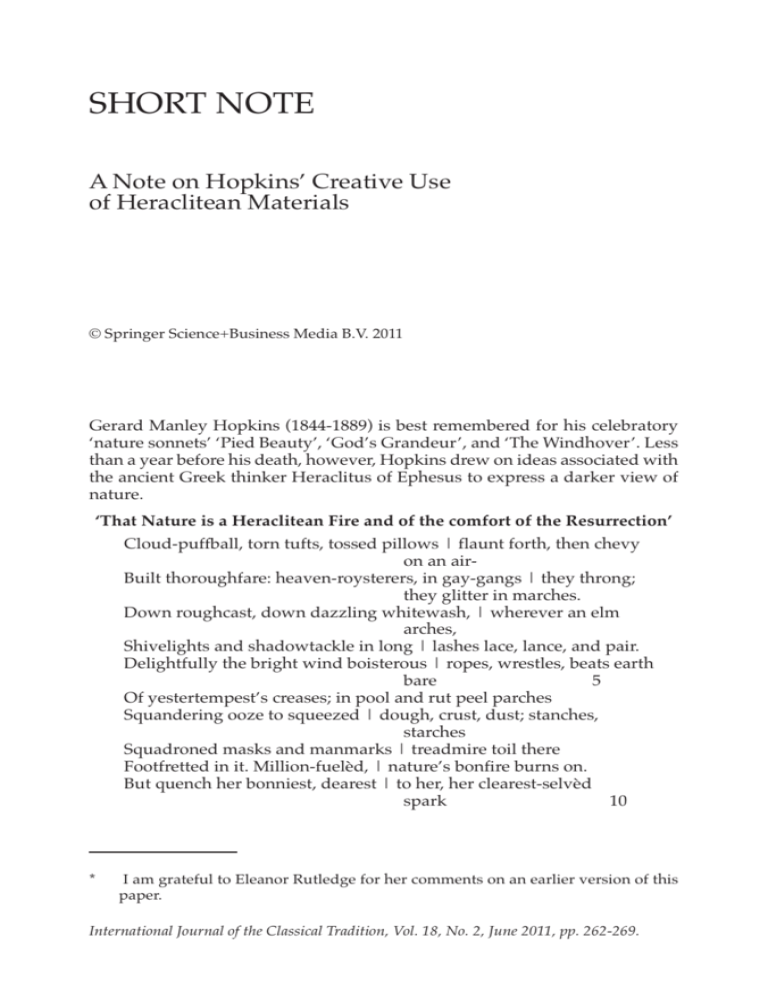
SHORT NOTE A Note on Hopkins’ Creative Use of Heraclitean Materials © Springer Science+Business Media B.V. 2011 Gerard Manley Hopkins (1844-1889) is best remembered for his celebratory ‘nature sonnets’ ‘Pied Beauty’, ‘God’s Grandeur’, and ‘The Windhover’. Less than a year before his death, however, Hopkins drew on ideas associated with the ancient Greek thinker Heraclitus of Ephesus to express a darker view of nature. ‘That Nature is a Heraclitean Fire and of the comfort of the Resurrection’ Cloud-puffball, torn tufts, tossed pillows | flaunt forth, then chevy on an airBuilt thoroughfare: heaven-roysterers, in gay-gangs | they throng; they glitter in marches. Down roughcast, down dazzling whitewash, | wherever an elm arches, Shivelights and shadowtackle in long | lashes lace, lance, and pair. Delightfully the bright wind boisterous | ropes, wrestles, beats earth bare 5 Of yestertempest’s creases; in pool and rut peel parches Squandering ooze to squeezed | dough, crust, dust; stanches, starches Squadroned masks and manmarks | treadmire toil there Footfretted in it. Million-fuelèd, | nature’s bonfire burns on. But quench her bonniest, dearest | to her, her clearest-selvèd spark 10 * I am grateful to Eleanor Rutledge for her comments on an earlier version of this paper. International Journal of the Classical Tradition, Vol. 18, No. 2, June 2011, pp. 262-269. Short Note 263 Man, how fast his firedint, | his mark on mind, is gone! Both are in an únfathomable, all is in an enormous dark Drowned. O pity and indig | nation! Manshape, that shone Sheer off, disseveral, a star, | death blots black out; nor mark Is any of him at all so stark 15 But vastness blurs and time | beats level. Enough! the Resurrection, A heart’s-clarion! Away grief’s gasping, | joyless days, dejection. Across my foundering deck shone A beacon, an eternal beam. | Flesh fade, and mortal trash Fall to the residuary worm; | world’s wildfire, leave but ash: 20 In a flash, at a trumpet crash, I am all at once what Christ is, | since he was what I am, and This Jack, joke, poor potsherd, | patch, matchwood, immortal diamond, Is immortal diamond.1 Notes: ‘Cloud-puffball…pillows’: clouds in various shapes; ‘chevy’: chase, run; ‘roysterers’: merry-makers; ‘roughcast’: a substance used to coat walls; ‘Shivelights and shadowtackle’: splinters of light and rope-like shadows; ‘rut peel parches’: the top layer of mud dries out; ‘Squadroned masks and manmarks’: different patterns of human footprints; ‘treadmire’: walk in mud; ‘Footfretted’: marked off by footprints; ‘manmarks’: traces of human activity; ‘firedint’: dent or mark left by fire; ‘mark on mind’: impression left in human memory; ‘Manshape…a star’: an individual’s distinctive achievements: ‘clarion’: trumpet call; ‘foundering deck’: a sinking ship; ‘Flesh fade’: human life passes away; ‘the residuary worm’: forces of dissolution; ‘Jack’: an ordinary individual; ’potsherd’: piece of broken clay; ‘matchwood’: kindling.2 Hopkins’ use of the adjective ‘Heraclitean’ naturally gives rise to three questions: (1) At what points do Heraclitean ideas or images figure in ‘That Nature’? (2) What would count as a distinctly ’Heraclitean’ fire and how would it relate to ‘the comfort of the Resurrection’? and (3) Does ‘That Nature’ express genuinely Heraclitean doctrines or did Hopkins draw on these materials to fashion a point of view all his own? As a student (later professor) of classical languages, Hopkins had direct access to the Greek texts included in the (then) standard edition of the teachings of the Presocratic philosophers, H. Ritter and L. Preller, Historia Philosophiae Graecae.3 It is clear from comments in his notebooks and letters to friends4 that Hopkins was familiar with the teachings of the Presocratic thinkers Xenophanes, Heraclitus, and Parmenides. In 1866, while still an undergraduate at Oxford, Hopkins converted to Roman Catholicism. In 1868 he started on the path to the priesthood (joining the Society of Jesus, being ordained as a priest in 1877) and taught at Catholic secondary schools and uni- 1. 2. 3. Phillips (1986, pp. 180-81). These glosses are taken largely from Phillips (1986) and Walliser (1987). First edition, 1838; second edition, 1857 (the edition Hopkins knew); cited in the text as ‘RP’. The nature of Hopkins’ classical education and its importance for his poetry are discussed in Arkins (1997) and West (2006). 264 International Journal of the Classical Tradition / June 2011 versities for the remaining two decades of his life. Both the philosophical and religious strands in Hopkins’ life figure in this extended reflection on ‘coming to be and passing away’. ‘That Nature’ begins from a view of nature and human existence marked by dissolution and decay, and concludes with an affirmation of the Christian promise of eternal life. The exclamation ‘Enough!’ in line 16 marks the point of transition from the first, joyless perspective to the second, triumphant one. The most relevant text here comes not from Heraclitus but from First Corinthians 15: 22: In a moment, in the twinkling of an eye, at the last trump: for the trumpet shall sound, and the dead shall be raised incorruptible, and we shall be changed. However Heraclitean images and ideas appear in both sections of the poem.5 Lines 1 through 9 depict a natural realm marked by movement, conflict, and dissolution: clouds in various shapes gather, separate, and march about the sky while light and shadows crisscross and impale (‘lance’) one another. Wind takes up where the sunlight leaves off, ‘delightfully’ flattening out ruts and gullies caused by earlier rains. Mankind makes its first appearance as a maker of indentations equally subject to obliteration. Nature, characterized as a ‘Million-fuelèd … bonfire’ (9) and ‘world’s wildfire’ (20) roars on. The obvious connection here is to Heraclitus’ B 30: This world order, <the same for all, > no god or man made, but it always was, is, and will be, an ever living fire, kindled in measures and extinguished in measures. (RP, p. 21)6 Students of Hopkins’ poetry7 have routinely glossed these references to ‘nature’s bonfire’ and ‘world’s wildfire’ as an affirmation of the doctrine of flux or universal change attributed to Heraclitus first by Plato (e.g. at Cratylus 402a, 4. 5. 6. 7. Higgins (2006, pp. 204-11, 235-55, and 308-22). As Walliser and others have noted, it is difficult to detect references to the teachings of any other Presocratic philosophers. In general, early Greek cosmologies posit cycles of birth, death, and re-birth, rather than the linear descent depicted here in ‘That Nature’. Foltz (1980) claims that Hopkins’ choice of diamond, the most durable form of carbon, was intended to evoke Parmenides’ view of ‘whatis’ (to eon) as eternal, indivisible, un-moving, and fully developed, thereby endorsing a combined Christian-Parmenidean metaphysics. But, unlike to eon, diamonds are neither eternal, indivisible, un-moving, or completely realized at every moment. Nor is it clear why Hopkins would have wanted to merge the Christian message of salvation with a Parmenidean metaphysics. Some editors (e.g. Kirk, 1954, pp. 308-09) have concluded that the phrase ‘the same for all’ (ton auton hapantôn) was added by Clement of Alexandria to reflect the Stoic doctrine of periodic and total conflagration. However, Marcovich (pp. 268-69) and others accept the phrase when read as ‘the same for all men’ (i.e. like the logos that is ‘common’, the world order is an objective reality). See Johnson (1972, p. 237); Walliser (1977, pp. 92-97, 104-105, and 121); C. Phillips (1986, p. 385); Cotter (1986, p. 265); Salmon (1990, pp. 31-32): Arkins (1997, p. 472); Cervo (1998, p. 135); and Moulin (2000), among others. Short Note 265 RP, p. 19) 8 and subsequently by many others. Yet neither the simile of an everchanging river nor the idea of universal change figures in Hopkins’ story here. Rather, like Heraclitus, Hopkins conceives of nature as a realm in which forms of the four basic elements—fire (bonfire, spark, star, wildfire, beacon, beam), air (clouds, ‘air-Built thoroughfare’, wind), earth (mire, ooze, dust, ash), and water (pool, tempests)—contend against and annihilate one another. As Heraclitus sums it up (in B 8, RP, p. 21): All things come about through strife. We learn some of the details in B 76 (RP, p. 22): Fire lives the death of earth and air lives the death of fire; water lives the death of air, earth that of water. Fire’s death is birth for air, and air’s death is birth for water. Similarly B 126 (RP, p. 23) describes how natural bodies acquire and then lose opposing qualities over time: Cold things become warm, a warm thing becomes cold; a moist thing becomes dry, a parched thing becomes moist. We learn also from B 31 (RP, p. 22) and B 90 (RP, p. 21) that fire takes on different substantial forms at different times, presumably in accordance with the governing principle or ratio—the Heraclitean logos or ‘account’: The turnings of fire: first sea, and of sea half is earth and half lightning storm … sea is poured forth <from earth> and is measured according to the same ratio (logos) as existed before it became earth. All things are an equal exchange for fire, just as goods are for gold and gold for goods. Thus the reality denoted by the phrase ‘Heraclitean fire’ is not flux or universal change but rather the way in which natural substances and qualities fight against and consume one another over time. So far, at least, Hopkins and Heraclitus share similar points of view. But while ‘That Nature’ depicts a realm of beings headed down toward annihilation (compare the sequence ‘down’, ‘down’, ‘quench’, ‘gone’, ‘drowned’, and ‘death’)9, Heraclitean nature sustains itself through a reciprocal exchange among its component parts. It is a cosmos or ‘elegant arrangement’ that ‘was, is, and will be’, not an irreversible de- 8. 9. ‘Heraclitus says somewhere that all things give way and nothing abides and likening existing things to the flow of a river, he says that you cannot step twice into the same river.’ For reasons to doubt Plato’s ‘flux’ reading of the river fragments see Kirk (1954, pp. 366-84) and more recently Colvin (2007, pp. 759-69). Hopkins was, however, familiar with the flux interpretation of Heraclitus and, at least at some point in his life, accepted it (see his essay on Presocratic philosophy in Higgins (2006, p. 206)). In this respect ‘That Nature’ traces out the same scenario envisaged in ‘Spelt from Sibyl’s Leaves’ (1886): ‘With: Our evening is over us, our night | whelms, whelms, and will end us.’ 266 International Journal of the Classical Tradition / June 2011 cline.10 For Heraclitus, but not for Hopkins, ‘the way down’ was the same as ‘the way up’ (B 60, RP, pp. 21-22).11 At line 10 ‘man’ (humankind) appears as the ‘bonniest’ of nature’s creatures12, yet the products of his intelligence disappear from view as readily as do footprints made in mud.13 Like boisterous clouds on parade, we human beings present a passing show, and then are no more. Human intelligence is identified as a kind of fire (‘his firedint’) much as Heraclitus states in B 118 (RP, p. 26) that ‘a flash of light is a dry soul, wisest and best.’14 The reference to ‘a star’ in line 14 echoes reports in Plutarch and other ancient writers (RP, p. 25) that Heraclitus linked individual souls with the fire in the heavens. But here too Hopkins goes only part of the way with Heraclitus. In ‘That Nature’ individual achievement is inevitably blotted out by the vastness of the universe and the passage of time: ‘nor mark / Is any of him at all so stark / But vastness blurs and time | beats level’. By contrast, according to Heraclitus B 63 (RP, p. 28), some individuals arise to become wakeful guardians of living men and corpses.15 The doubly chiastic structure of B 62 (RP, p. 28) points toward the nature of the larger reality: athanatoi thnêtoi thnêtoi athanatoi zôntes ton ekeinôn thanaton ton de ekeinôn bion tethneôtes Immortals mortals: mortals immortals: living their death and having died their life. Mortals and immortals, i.e. human beings and gods, live in alternation with one another.16 They ‘live each other’s deaths and die each other’s lives’ in the 10. As is well known, the Greek noun kosmos is etymologically related the verb kosmeô: ‘arrange, marshal’, and literally means ‘an ordering or arrangement’, especially an elegant or beautiful one. 11. Adam Czerniawski (2003, pp. 40-41) has observed that the degree of continuity implied in ‘kindling in measures and dying out in measures’ sits uneasily with Hopkins’s one-way vision of nature as headed toward destruction. 12. There is no reason to regard this as an ironic or sarcastic characterization. Hopkins elsewhere speaks of man as God’s finest creation (see McNamee 1979, pp. 235-36). 13. Walliser (1977, p. 97) states that ‘Hopkins treats nature and man separately in the poem. This would have been inconceivable for Heraclitus or any other Presocratic philosopher because for them man is an integral part of nature.’ But while Hopkins depicts nature before turning to ‘man’ it is clear that man and nature alike are mired in conflict and dissolution. 14. B 118 does not unambiguously identify the soul as a kind of fire, as opposed to some other kind of substance (perhaps air or vapor) that at certain points can become fiery (see the discussion in Kahn, 1979, pp. 248-51). 15. Hippolytus (Refutation of All Heresies IX, 10.6) quotes the remark to establish that Heraclitus shared the Christian belief in bodily resurrection, although it is not clear why being ‘a wakeful guardian’ would require having a body. 16. ‘Chiasmus … is the crosswise arrangement of contrasted pairs to give alternate stress … Cp. “Sweet is the breath of morn and her rising sweet”’ (Smyth [1984, Sec. 3020]). Short Note 267 same way in which the elements feed off each other, i.e. some gods become human beings while at least some human beings achieve divine status. As B 88 (RP, p. 28) states: And as one and the same thing, there is present [in us] living and dead, waking and sleeping, young and old. For these having changed round are those and those having changed round are these. Similarly, according to Aetius (a 2nd-century compiler of earlier views): Heraclitus said that the soul is indestructible. For when it departs [the body] and goes back to the soul of the universe, it returns to that to which it is identical in kind. (A 17) For Heraclitus, then, the soul has both its origins and its ultimate destination in the universe, although this story may apply primarily to those who can in some manner keep their souls ‘dry’.17 Hopkins adopts one aspect of Heraclitus’ way of thinking—his view of the soul (at least at its best) as a kind of fire—but embeds it within a more pessimistic framework. In Hopkins’ somber vision, ‘man’s firedint, his mark on mind’ is ‘in an enormous dark drowned.’ In the three last lines we arrive at ‘the comfort of the Resurrection’ through the identification of the ordinary individual (‘Jack’) with ‘what Christ is … immortal diamond’.18 Although the mention of ‘a trumpet crash’ and ‘all at once’ call to mind the end time at which the bodies of the faithful will be raised, the focus here is on the promise of eternal life made to mankind through the death and resurrection of Christ.19 The gospel of Christ is the ‘beacon, an eternal beam’ that shines out even when nature and humankind have been reduced to ash. Human nature is depicted as a composite of natural substances, but the sequence ‘poor potsherd, patch, matchwood, immortal diamond’ is probably best understood (following Walliser 1977, p. 119) as a progression from ‘things that are not whole and no longer in their original condition’ to that which is both original and permanent. To conclude: in ‘That Nature’ Hopkins made extensive use of Heraclitean materials to fashion a gloomy vision of nature, only to reject that vision in favor of the Christian promise of eternal life.20 In the process he converted Heracli- 17. B 24 and 25 speak of those who die in battle as having ‘better destinies’ But in light of common ancient conviction that ‘like knows like’ it seems likely that Heraclitus associated wisdom with aligning one’s soul with the fiery (and drying) power that rules the cosmos. 18. Cf. Hopkins’ ‘Heaven Haven’ (‘Rest’) and ‘He hath abolished the old drouth’ ‘ (both 1864). 19. Cf. First Peter 1:3: ‘According to His great mercy, He has given us a new birth into a living hope through the resurrection of Jesus Christ from the dead’ (cf. Second Corinthians 5:17-21). 20. Based on what he regarded as analogies between aspects of Heraclitus’ teachings and elements of ‘That Nature’, Michael Johnson claimed (1972, p. 241) that Hopkins sought to achieve ‘a fusion of Heraclitean philosophy and Christian theology.’ More plausibly, T. J. Steele (1997, p. 234): ‘Where nature has only a bonfire, a 268 International Journal of the Classical Tradition / June 2011 tus’ conception of nature as a self-sustaining system into a vision of a oneway decline toward destruction, and set Heraclitus’ positive characterization of human intelligence as a kind of fire within a far more pessimistic framework. In an oft-quoted letter21 to his friend and fellow poet Robert Bridges, Hopkins stated that his use of Greek philosophical materials had led him to a distinctly non-Greek conclusion: … and lately I sent you a sonnet, on the Heraclitean fire, in which a great deal of early Greek philosophical thought was distilled; but the liquor of the distillation did not taste very Greek did it? But in the next, less often-quoted sentence Hopkins confirms that he was prepared to make creative use of materials he inherited from earlier thinkers: The effect of studying masterpieces is to make me admire and do otherwise. James Lesher Department of Phliosophy University of North Carolina Works Cited Abbott, Claude, ed., The Letters of Gerard Manley Hopkins to Robert Bridges (London and Oxford: Oxford University Press, 1955). Arkins, Brian, ‘Greek Themes in Hopkins,’ International Journal of the Classical Tradition 3 (1996/97), pp. 458-72. Cervo, Nathan, ‘Hopkins’s “That Nature Is a Heraclitean Fire and of the comfort of the Resurrection”,’ Explicator 56 (1998), pp. 135-36. Colvin, Matthew, ‘Heraclitean Flux and Unity of Opposites in Plato’s Theaetetus and Cratylus,’ Classical Quarterly 57 (2007), pp. 759-69. Cotter, James, ‘Apocalyptic Imagery in Hopkins’ “That Nature is a Heraclitean Fire and of the comfort of the Resurrection”,’ Victorian Poetry 24 (1986). pp. 261-73. Czerniawski, Adam, ‘Holy Heraclitus,’ Poetry Nation Review (March-April, 2003), pp. 38-42. Foltz, William, ‘Hopkins’ Greek Fire,’ Victorian Poetry, Vol. 18 (1980), pp. 23-34. Heraclitus, The Cosmic Fragments, Edited with an introduction and commentary by G. S. Kirk (Cambridge: Cambridge University Press, 1954). Heraclitus, Greek text with a short commentary, ed. and comm. Miroslav Marcovich, International Pre-Platonic Studies 2 (Sankt Augustin: Academia Verlag, 2001). Higgins, Lesley, ed., Gerard Manley Hopkins: Oxford Essays and Notes (Oxford: Oxford University Press, 2006). bone-fire to offer us, the supernatural and miraculous dimension of Christianity assures us that our resurrected life will recapitulate and eternally perpetuate all our earthly reality’. 21. Abbot (1955, p. 291). Short Note 269 Johnson, Michael, ‘Cosmic Instress and of the Comfort of the Resurrection,’ Victorian Poetry 10 (1972), pp. 235-42. Kahn, Charles, The Art and Thought of Heraclitus (Cambridge: Cambridge University Press, 1979). McNamee, Maurice, S. J., ‘Hopkins, Poet of Nature and of the Supernatural’ in Weyand (1979), pp. 222-51. Moulin, Joanny, ‘“Meaning Motion”; Gerard Manley Hopkins with Heraclitus via Heidegger,’ The Gerard Manley Hopkins Archive http://www.gerardmanleyhopkins .org/lectures_2000/heraclitus.html). Phillips, Catherine, ed., Gerard Manley Hopkins: Selected Poetry, ser. The Oxford Authors (Oxford: Oxford University Press, 1986). Ritter, H. and L. Preller, Historia Philosophiae Graecae (Gotha: Friedrich Andreas Perthes, 1838; second edition, 1857, with ten subsequent editions). Salmon, Rachel, ‘Frozen Fire: The Paradoxical Equation of “That Nature is a Heraclitean Fire and of the comfort of the Resurrection”’ in Sulloway (1990), pp. 21-34. Smyth, Herbert W., Greek Grammar (Cambridge, Mass.: Harvard University Press, 1984). Steele, Thomas, S. J., ‘Hopkins’ Masonic Bonfire,’ Victorian Poetry 35 (1997), pp. 233-35. Sulloway, Allison, ed., Critical Essays on Gerard Manley Hopkins, ser. Critical Essays on British Literature (Boston: G.K. Hall, 1990). Walliser, Stephan, That Nature is a Heraclitean Fire and of the Comfort of the Resurrection, The Cooper Monographs on English and American Language and Literature 26 (Bern: Francke, 1977). Weyand, Norman, S. J., ed., Immortal Diamond: Studies in Gerard Manley Hopkins (New York: Octagon Books, 1979). West, Stephanie, ‘Classical Notes on Gerard Manley Hopkins,’ International Journal of the Classical Tradition 13 (2006/07), pp. 21-32.

